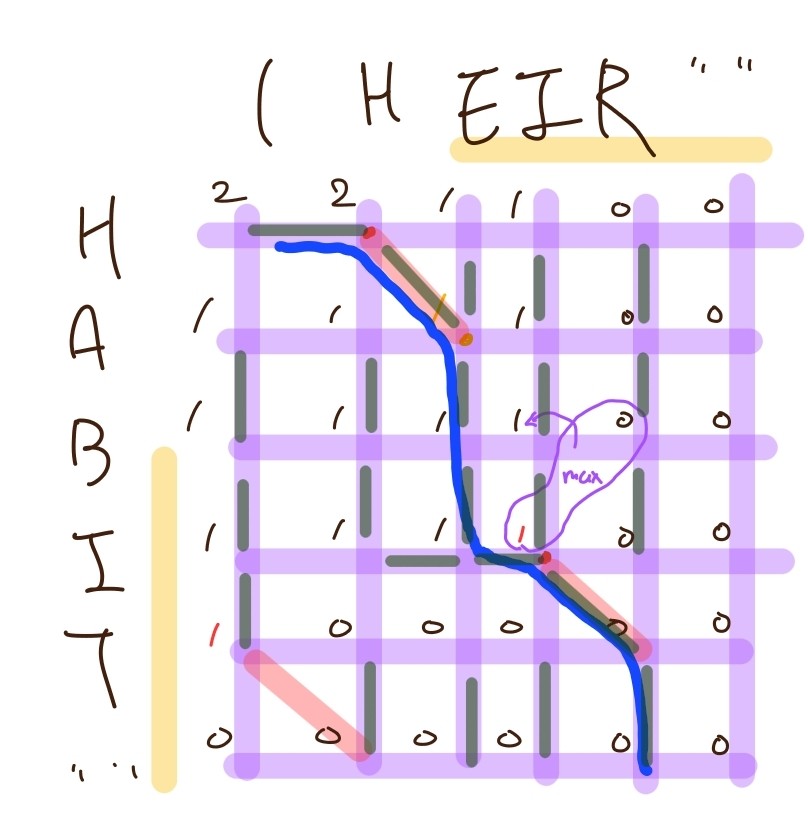[Lecture Summary] 15 Algorithm and Data Structure : DP Subproblems
This contents is based on Lecture of link
Overview
KEY idea of DP is
- subproblems have dependencies which overlap for several times. We can formulate that dependencies into DAG.
- Solve problem with Top-down approach which re-use already solved and recorded solutions. Recurse!
- Iterating subproblems can be considered as Bottom-up approach. Careful “Brute Force”!
Longest Common Subsequence(LCS)
- Input: two strings $A$ and $B$
- Output : longest subsequence of $A$ that is also a subsequence of $B$
Something different from “Bowling” problem is that LCS requires 2 inputs and therefore subprblems for multiple inputs. To do so, multiply(cross product) subproblem spaces!
Formulation
-
Subproblems :
$L(i, j) = LCS(A[i:], B[j:]), i\in [0, \mid A \mid ] j\in [0, \mid B \mid]$ -
Relation :
$ L(i,j) = $
(if $A[i]==B[j]$), $1 + L(i+1, j+1)$
(else) $\max \lbrace L(i+1, j), L(i,j+1)\rbrace$ -
Topological Order :
(Decreasing index order)
for $\mid A \mid \cdots 0$ for $\mid B \mid \cdots 0$ -
Base Case :
$L(i,\mid B \mid) = L(\mid A \mid, j) = 0$ -
Original Problem :
$L(0,0)$ -
Time :
| Category | Time |
|---|---|
| # of subproblems | $(\mid B \mid+1)(\mid A \mid +1)$ |
| nonrecursive work | $O(1)$ |
| In total | $O(\mid A \mid\cdot \mid B \mid)$ |
We can think of this solution as follows:
- For a given state(position) $i$ and $j$, check whether they are same with each other
- If they are different, then drop it!
- Check the matches only and count left-over.
Example

Longest Increasing Subsequence(LIS)
- Input: one strings $A$
- Output : longest subsequence of $A$ that strictly increase
- String is int
The thing is that we need an information to determine wheter LIS includes current string or not.
Formulation
- Subproblems :
$L(i) = LIS(A[i:])$ that starts with $A[i]$. This constraint does matter to solve this problem. Because we do not know whether $A[i]$ is included in LIS or not, we assume that it does.
- Relation :
Naive approach : $ L(i) = \max \lbrace L(i+1), 1+L(i+1) \rbrace$ does not work because it does not support the above constraint.
Final approach : $L(i) = 1 + \max \lbrace L(j) \mid i < j \ge n, A[i] <A[j] \rbrace \cup \lbrace 0 \rbrace$
✔️ The first term originated from the constraint that $A[i]$ is included in LIS
✔️ Union is devised to support case that $A[i]$ always larger than following String.
- Topological Order :
Decreasing $i$
- Base Case :
$L(\mid A \mid) = 0$
- Original Problem :
$\max \lbrace L(i) \mid i \in [0, \mid A\mid] \rbrace$.
We can consider this solution as if we assume the starting point of LIS, then we can define LIS value and search every case of LIS
- Time :
| Category | Time |
|---|---|
| # of subproblems | $(\mid A \mid)$ |
| nonrecursive work | $O(\mid A \mid)$ |
| In total | $O(\mid A \mid\cdot \mid B \mid)$ |
Time to run non-recursive work is the number of cases of starting LIS. We can improve time using AVL tree augmentation!(TODO)
댓글남기기